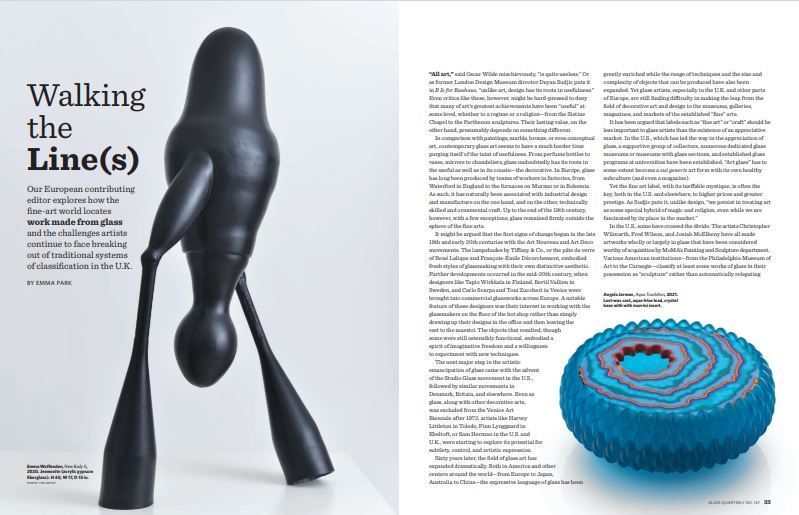The Summer 2022 edition of Glass: The UrbanGlass Art Quarterly (#167) is arriving in subscriber mailboxes and on newsstands. On the cover is a majestic white Raven by Preston Singletary, whose work is currently featured in a multimedia exhibition at the Smithsonian's National Museum of the American Indian in Washington, D.C. Based on extensive research Singletary did into his native culture, and specifically Tlingit creation myths, the artist sought to advance the legends of his Native American forebears by depicting them in contemporary materials. The resulting high-profile exhibition "Raven and the Box of Daylight" stands as one of the successful artist's most widely viewed exhibitions and advances his stature as a Tlingit representative to the wider world.

The cover article entitled "Firekeeper" includes an in-depth conversation between Glass managing editor Sadia Tasnim and Singletary exploring some of the complexities of artists who work from their native heritage, and includes a discussion of a tense encounter the artist had when challenged about his artwork and intentions by a tribal elder. Read the full article to learn more about how Singletary navigates the past and finds new relevance in the timeless stories of his ancestors.

Next up is the first in a three-part series by Glass contributing editor Samantha De Tillio that charts the use of glass as a material in performative artworks. Despite the popularity of sorting the evolution of art with glass into a neat linear narrative, creativity doesn't follow simple chronologies, a point De Tillio acknowledges in her extensively researched article opening. She traces various threads as she states the "origins of the relationship between contemporary glass and performance is evident in the artwork of the 1960s and 1970s," and goes on to examine body art, musical performances, and, of course, the theater of the glass studio itself, through the diverse projects of a wide cast of early glass art pioneers that expands the standard narrative of glass history.

Speaking of breaking out of narrow histories, London-based contributing editor Emma Park examines the struggles of artists working with glass to escape the narrow confines of decorative or design categories. With a focus on the U.K., Park writes about artists' desires to be embraced as contemporary makers in a dynamic that will likely have resonance for glass artists and collectors around the world. Looking in-depth at the experiences of Emma Woffenden and Angela Jarman, Park traces the challenges and breakthroughs that make riveting reading to anyone interested in advancing the appreciation for work being done in glass.
For the Summer 2022 edition, Park also traveled up to the pine forests of the southern province of Småland, Sweden, to witness a transformation underway at the historic glass house of Kosta Boda. As part of our 2022 International Year of Glass series, "Glass Around the World," we are examining glass facilities in far-flung locales, and Park has discovered that the new owners of this remote glass factory are leveraging the rural setting of their facility to combine glass production with luxury travel. Kosta Boda now functions as a vacation destination, luring the public to travel there not only for world-class glass art and design, but relaxation and restoration. Park looks at the legacy of this facility that nurtured glass artists such as Ann Wolff and Bertil Vallien, as it has weathered globalization and changing tastes in the decorative glassware for which Kosta Boda is most well-known.

Our last feature is a lushly illustrated excerpt from a new book on legendary kilnforming artist Klaus Moje. The definitive monograph tells the complete story of the German artist who traveled the world to generously share his refined techniques, finally settling in Australia where he founded the famous Glass Workshop at the Canberra School of Art, and spent his remaining years mentoring a generation of Australian glass artists. Nola Anderson, the author of Glass: The Life and Art of Klaus Moje, has set a new standard in biographical publications with her ambitious synthesis of cultural, social, art, and personal histories, which she distills into a highly readable work chronicling a remarkable life and artist. The article is illustrated with photographs by the artist himself, and reveals a keen eye for the telling details that take Moje's achievement to the highest levels of accomplishment in the field.
All this, plus reviews, news, and an illuminating essay by Michael Estes Taylor on the early community spirit before the Glass Art Society was formed -- in a rollicking tale of friendship, camaraderie, and how glass was the perfect art material for the counterculture in the 1960s and 1970s.
Subscribe and don't miss a single issue.




